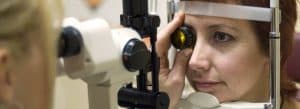Diabetic retinopathy affects over 30 percent of people with diabetes.
Diabetic retinopathy is a serious vision-threatening eye disease, caused by uncontrolled, high blood sugar levels, in people with diabetes.
Always follow your doctor’s advice to protect your vision and reduce your risk of developing diabetic retinopathy.
1. Visit your eye doctor for annual eye exams
Diabetic retinopathy typically does not present with any noticeable symptoms in its early stages. It is therefore crucial for people with diabetes to have annual comprehensive eye exams, to detect signs of the disease even before symptoms are noticed.
During a comprehensive eye exam, your eye doctor will use special diagnostic tools and imaging techniques to evaluate your retina, macula, and optic nerve, and look for signs of damage.
Early detection will enable optimal treatment outcomes, and increase your chances of preserving your vision.
2. Control your blood sugar
Diabetes prevents your body from using and storing sugar properly, causing excessive amounts of sugar to remain in the bloodstream. The high glucose levels cause damage to the blood vessels throughout the body, including your eyes.
When your blood sugar remains high for a long time, it can affect the shape of your eye’s lens, causing blurry vision. If uncontrolled, it can lead to loss of vision and permanent blindness.
Maintain control over your blood sugar levels to protect your eyes from damage and prevent vision loss.
If you have diabetes, contact an eye doctor near you, who can diagnose and discuss the best treatment options.
SEE RELATED: Are You at Risk for Diabetic Eye Damage?
3. Maintain healthy blood pressure and cholesterol levels
Maintaining healthy blood pressure and cholesterol levels will not only help to keep your heart healthy, but your eyes as well. Having chronic high blood pressure and cholesterol can increase your risk of diabetic retinopathy and vision loss.
Speak to your doctor to discuss the most effective ways to keep your blood pressure and cholesterol levels at a constant healthy level.
4. Quit smoking
There are three reasons why smoking is dangerous for people with diabetes.
- Smoking increases inflammation in the body. When cigarette smoke damages the cells in the body, it interferes with proper cell functioning and causes inflammation in the body. Swollen blood vessels are prone to breaking, and can cause fluid to leak into the retina, resulting in damage and vision loss.
- Smoking causes oxidative stress, which occurs as chemicals from the smoke combine with the oxygen in the body. Oxidative stress causes damage to cells, including those in your eyes.
- Exposure to high levels of nicotine reduces the efficiency of the insulin that lowers your blood sugar. As a result, you may need larger doses of insulin to control blood sugar levels.
If you smoke, or live with someone who smokes, it is highly recommended to seek professional advice on how to quit.
5. Exercise
Exercise is good for your overall health, both physical and emotional. Exercise is also good for controlling and reducing your blood sugar levels.
It is a good idea to create a regular exercise routine to help you maintain a healthy body and healthy eyes. Choose a partner to exercise with or consider taking classes at the gym— the more fun you are having while you work up a sweat, the more likely you will stick to a regular routine.
Caution: Always consult with your doctor before beginning any new exercise program.
LEARN MORE: Guide to Eye Conditions
Schedule an appointment with an eye doctor for a comprehensive eye exam, and to discuss any questions you may have about your diabetes.
If you have diabetes, you may be at risk of developing diabetic retinopathy. To reduce your risk and protect your ocular health and vision, follow our recommendations to control your diabetes and maximize your health.










